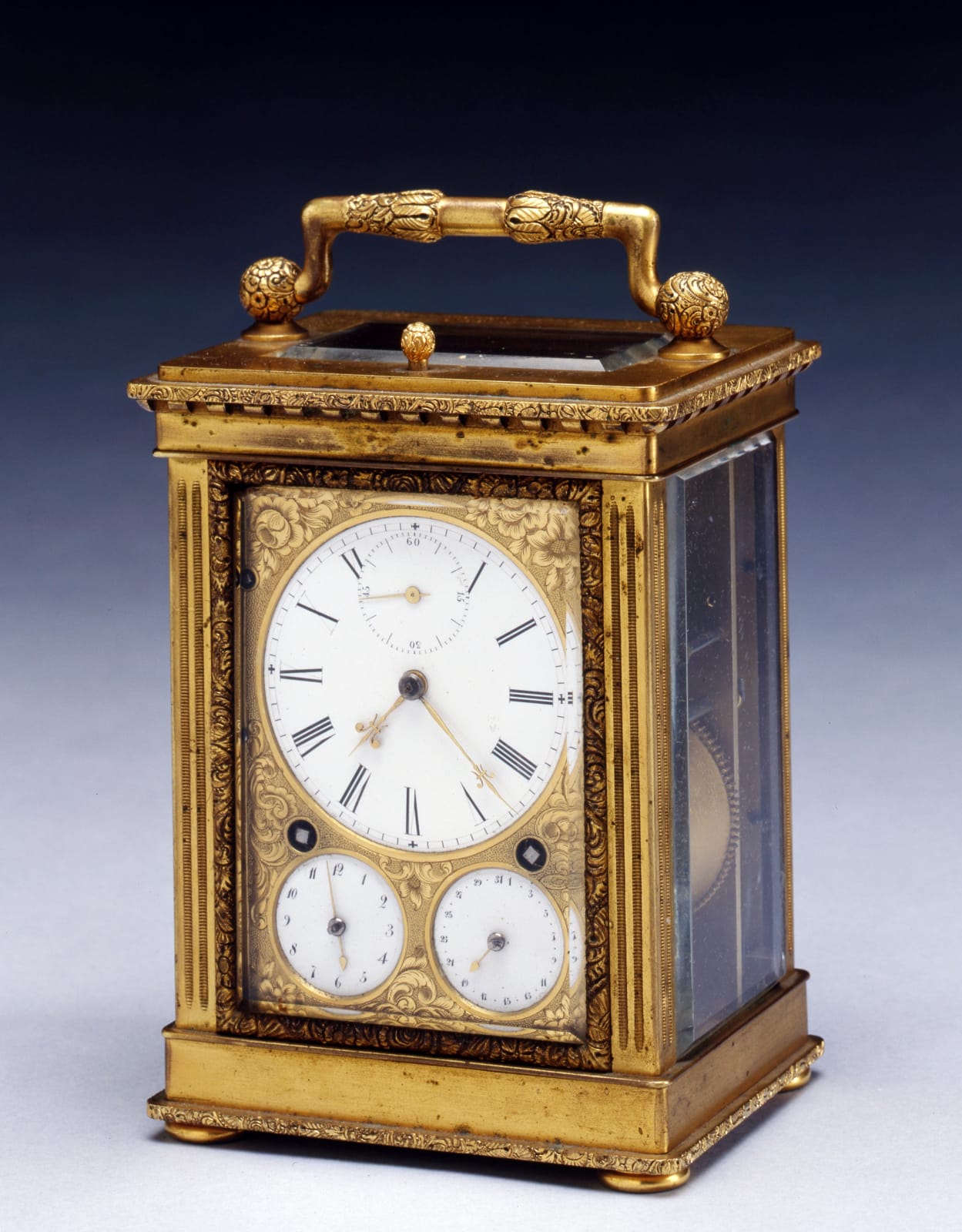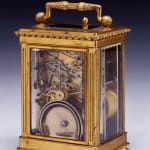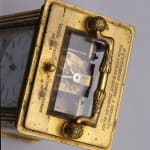Frédéric-Alexander Courvoisier
Further images
Literature
Alfred Chapuis, "Histoire de la Pendulerie Neuchâteloise", 1917, pp. 432-3, illustrating and describing an almost identical clock and its movement by 'Fritz' Courvoisier. Charles Allix, "Carriage Clocks, their History and Development", 1974, p. 311, pls. X/5 and 6, illustrating an almost identical clock and its complicated movement by 'Fritz' Courvoisier, also signed C.F. Klentschi on the movement, in the Musée d'Horlogerie à La Chaux-de-Fonds. Derek Roberts, "Carriage and other Travelling Clocks", 1993, pp. 242-3, pl. 154 a & b, illustrating another very similar carriage clock by Courvoisier.
A very rare early nineteenth century Swiss gilt brass Grande Sonnerie carriage clock of eight day duration made by the eminent maker Frédéric-Alexander Courvoisier, known as Fritz and retailed by Henri-Constant Borel, engraved on the top ECHAPPEMENT LIBRE A RESSORTS/ TROIS LEVEES & HUIT TROUS EN RUBIS/ PETITE SONNERIE DE JOUR/ REPETITION/ GRANDE SONNERIE DE NUIT/ HENRI BOREL.
The white enamel dial with Roman numerals and gilt brass hands for the hours and minutes with subsidiary seconds disc below 12 o'clock and two further subsidiary discs below the main dial, one to left for the alarm and the other to the right for calendar indications. The movement with pivoted detent chronometer escapement, compensated balance, grande sonnerie from 8 p.m. until 8 a.m. automatically changing to petit sonnerie during the day, striking, alarm and repeat with calendar indications. The gilt brass case with a fine engraved mask, glazed front, top and sides, housed in its original tooled leather travelling case with backward opening top to reveal the finely cast carrying handle, glazed top and repeat lever La Chaux-de-Fonds,
Switzerland, date circa 1830-35
Height with handle 18 cm.
The very close similarity between this piece and the Swiss carriage clocks listed above provide enough evidence to prove that the present work was also by Frédéric-Alexander Courvoisier, known as Fritz. It exhibits all the qualities of the other complex mechanisms and thus can be considered among the few true early Swiss carriage clocks. The name of Henri Borel engraved on the top refers to Borel acting in the capacity as retailer rather than maker. Only a relatively small number of nineteenth century Swiss carriage clocks were produced, the majority of which were made in or around La Chaux-de-Fonds and principally by the Courvoisier family. Fritz Courvoisier (1799-1854) was the second son of Louis (1758-1832) who had founded the firm of J. Robert et Fils et Cie with Josué Robert. After several changes the firm was known Courvoisier et Cie, 1811-45. Allix notes that although Fritz received more commercial horological rather than practical training he had attended a horological school run in the canton of Neuchâtel by Henri-Louis Maillardet and Charles Frédéric Klentschi.
He later travelled extensively as a representative of the family business. Following his marriage in 1826 he had about three years before he became involved in serious local political troubles. He rose to rank of Lieutenant Colonel and in 1831 was temporarily banished from the canton. However after the death of his father in 1832 he and his brothers, Henri-Louis and Philippe-Auguste reconstituted the firm of Couvoisier et Cie. He then left the family firm in 1842 to set up his own business and thereafter tended to specialise in retailing watches.
Henri Borel (1790-1849), who retailed the present work, was also an excellent manufacturer of complex carriage clocks likewise with subsidiary seconds, alarm and calendar discs. He was born at Couvet and died at La Chaux-de-Fonds and at times worked in association with Klentschi, for instance from 1818 they produced movements for pendules d'officier on behalf of Robert et Courvoisier. Borel is also recorded having supplied Maison Philippe Dubois at Locle with mahogany clocks and a pendule 'à la Hollandaise'.







